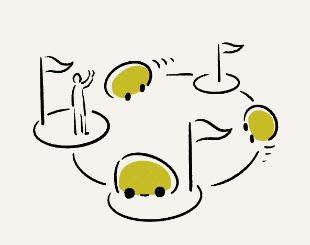
Group 02.
Control and Continuous Optimization
Understand the mobility society as a dynamic collection of networks, and analyze it by utilizing machine learning techniques.
Aiming to optimize and quasi-optimize the increasingly large and complex mobility society by making full use of the knowledge of control engineering and continuous optimization. Find methodologies that provide optimal mobility for individuals with diverse objectives.
In today’s society, people are connected to each other through social media, and with the advent of the IoT and the age of automatic driving, cars, industrial products, and electrical appliances are becoming more and more connected to each other. It is certain that all things will be further networked in the future, and human mobility will also be built on a social network infrastructure called “MaaS.” It is expected that in the near future, the information aggregated by MaaS will be used to achieve optimal mobility. However, the problems that must be solved to build such systems are concurrently becoming overwhelmingly large and complex. The Control and Continuous Optimization Group hopes to find new methodologies to solve multi-objective and equilibrium problems in mobility through the knowledge of optimization and control engineering.
Research Outline
In MaaS, which efficiently controls tens of thousands of moving objects such as cars and people, the state of things in existence changes from moment to moment (dynamic system). Moreover, there are multiple moving decision-making entities, and an equilibrium problem must be solved to find the optimal “landing place” for them. Furthermore, the moving subjects have several different wishes, such as “to get to the destination quickly” and “to get there by cheaper means” (multi-purpose problem). It is not easy to mathematically obtain optimal or equilibrium solutions to such large and complex problems.
The goal of our group is to discover methodologies for finding “quasi-optimal solutions” to such multi-objective and equilibrium problems, based on the knowledge of control engineering and continuous optimization. For example, a “decentralized” control system design could be considered. Processing the entire system on a central computer requires enormous computing resources, but calculations for only certain areas can be handled by computers with low processing power instead. Specifically, we are conducting research to optimize a ride-and-leave car-sharing system within a certain geographic area by combining rates that vary depending on the uneven distribution of cars. We also believe that the research results of our group may provide a tool for each individual participant in a social system to obtain a satisfactory solution (including quasi-optimal solutions). With the increase in connections through social media and the visualization of information, there are more opportunities to feel a sense of “unfairness” than ever before. However, there is a possibility to reduce social dissatisfaction by specifying mathematically optimal and equilibrium solutions. In addition, once we have found a path to optimize the car-sharing system, we plan to explore other mobility applications (e.g., cab dispatch, home delivery, delivery, and control and measurement of other mobile vehicles).
Participating Members
| Kazunori Sakurama | Graduate School of Engineering Science, The University of Osaka |
| Nobuo Yamashita | Graduate School of Informatics, Kyoto University |
| Kenji Kashima | Graduate School of Informatics, Kyoto University |
| Shunichi Azuma | Graduate School of Informatics, Kyoto University |
| Naoki Hayashi | Graduate School of Engineering Science, The University of Osaka |
| Shigeaki Innan | Graduate School of Engineering Science, The University of Osaka |
| A. Daniel Carnerero | Graduate School of Engineering Science, The University of Osaka |
| Yuya Yamakawa | Faculty of Economics and Business Administration Graduate School of Management, Tokyo Metropolitan University |
| Takuya Ikeda | Faculty of Environmental Engineering, The University of Kitakyushu |
| Chengyan Zhao | College of Science and Engineering Department of Mechanical Engineering, Ritsumeikan University |
| Hiroshige Dan | Faculty of Science and Engineering, Waseda University |
| Shunsuke Hayashi | Faculty of Science and Engineering, Hosei University |
| Daiki Sugiyama | Graduate School of Informatics, Kyoto University |
| Shoju Enami | Graduate School of Informatics, Kyoto University |
| Sotaro Fushimi | Graduate School of Informatics, Kyoto University |
| Yuhei Takada | Graduate School of Informatics, Kyoto University |
| Shota Tanaka | Graduate School of Engineering Science, The University of Osaka |
| Koga Sato | Graduate School of Engineering Science, The University of Osaka |
| Yusei Furusato | Graduate School of Engineering Science, The University of Osaka |
| Hayato Kobayashi | Graduate School of Engineering Science, The University of Osaka |

